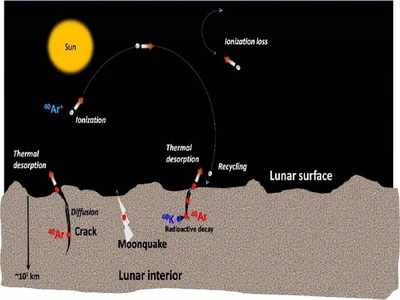- News
- India News
- Chandrayaan-2 finds easily detectable ‘Argon-40’ isotope
Trending
This story is from October 31, 2019
Chandrayaan-2 finds easily detectable ‘Argon-40’ isotope
The Indian Space Research Organisation (Isro) on Thursday said that the Chandra’s Atmospheric Composition Explorer-2 (CHACE-2) payload on Chandrayaan-2 has detected Argon-40 (40Ar) from the lunar exosphere.

Key Highlights
- Among the radiogenic gases on the lunar surface, 40Ar is one of the isotopes of Argon, a noble gas
- The detection of 40Ar is significant for Isro, but this won’t be the first time that the isotope has been studied, given that it has a high escape rate
BENGALURU: The Indian Space Research Organisation (Isro) on Thursday said that the Chandra’s Atmospheric Composition Explorer-2 (CHACE-2) payload on Chandrayaan-2 has detected Argon-40 (40Ar) from the lunar exosphere.
Among the radiogenic gases on the lunar surface, 40Ar is one of the isotopes of Argon, a noble gas. “Argon, is an important constituent of the lunar exosphere. It originates from the radioactive disintegration of Potassium-40 (40K), which has a half-life of 1.2 X 109 years,” Isro said in a statement it made public on Wednesday evening.
The statement further read that 40K nuclide, which is present deep below the lunar surface, disintegrates to 40Ar, which, in turn, makes way up to the lunar exosphere through seepages and faults.
The detection of 40Ar is significant for Isro, but this won’t be the first time that the isotope has been studied, given that it has a high escape rate.
Argon-40 escapes from Moon at a surprisingly high rate that is between 3% and 6% of its total production.
“Its brief lifetime in the lunar exosphere is marked by numerous adsorption/desorption events. Collisions with the lunar surface in cold, permanently shaded areas lead to long term storage, forming reservoirs of trapped gas that may be disturbed occasionally to produce sudden increases in atmospheric argon,” the paper adds.
It is postulated that this may explain at least part of the time variations in Apollo 17 mass spectrometer measurements of argon that were previously attributed to internal processes associated with the release of radiogenic gases from the moon.
Among the radiogenic gases on the lunar surface, 40Ar is one of the isotopes of Argon, a noble gas. “Argon, is an important constituent of the lunar exosphere. It originates from the radioactive disintegration of Potassium-40 (40K), which has a half-life of 1.2 X 109 years,” Isro said in a statement it made public on Wednesday evening.
The statement further read that 40K nuclide, which is present deep below the lunar surface, disintegrates to 40Ar, which, in turn, makes way up to the lunar exosphere through seepages and faults.
The detection of 40Ar is significant for Isro, but this won’t be the first time that the isotope has been studied, given that it has a high escape rate.
R Richard Hodges from the University of Colorado Boulder, in a research paper published earlier, says: “In polar areas of the moon the maximum temperatures reached in some permanently shaded areas are well below the temperature required to retain water ice for billions of years, and cold enough to hold other volatiles for shorter periods. Aside from water, the most significant lunar volatiles are the radiogenic gases, of which argon-40 is the most easily detected, both in situ and as retrapped ions in rocks returned from the surface on the moon.”
Argon-40 escapes from Moon at a surprisingly high rate that is between 3% and 6% of its total production.
“Its brief lifetime in the lunar exosphere is marked by numerous adsorption/desorption events. Collisions with the lunar surface in cold, permanently shaded areas lead to long term storage, forming reservoirs of trapped gas that may be disturbed occasionally to produce sudden increases in atmospheric argon,” the paper adds.
It is postulated that this may explain at least part of the time variations in Apollo 17 mass spectrometer measurements of argon that were previously attributed to internal processes associated with the release of radiogenic gases from the moon.
End of Article
FOLLOW US ON SOCIAL MEDIA










